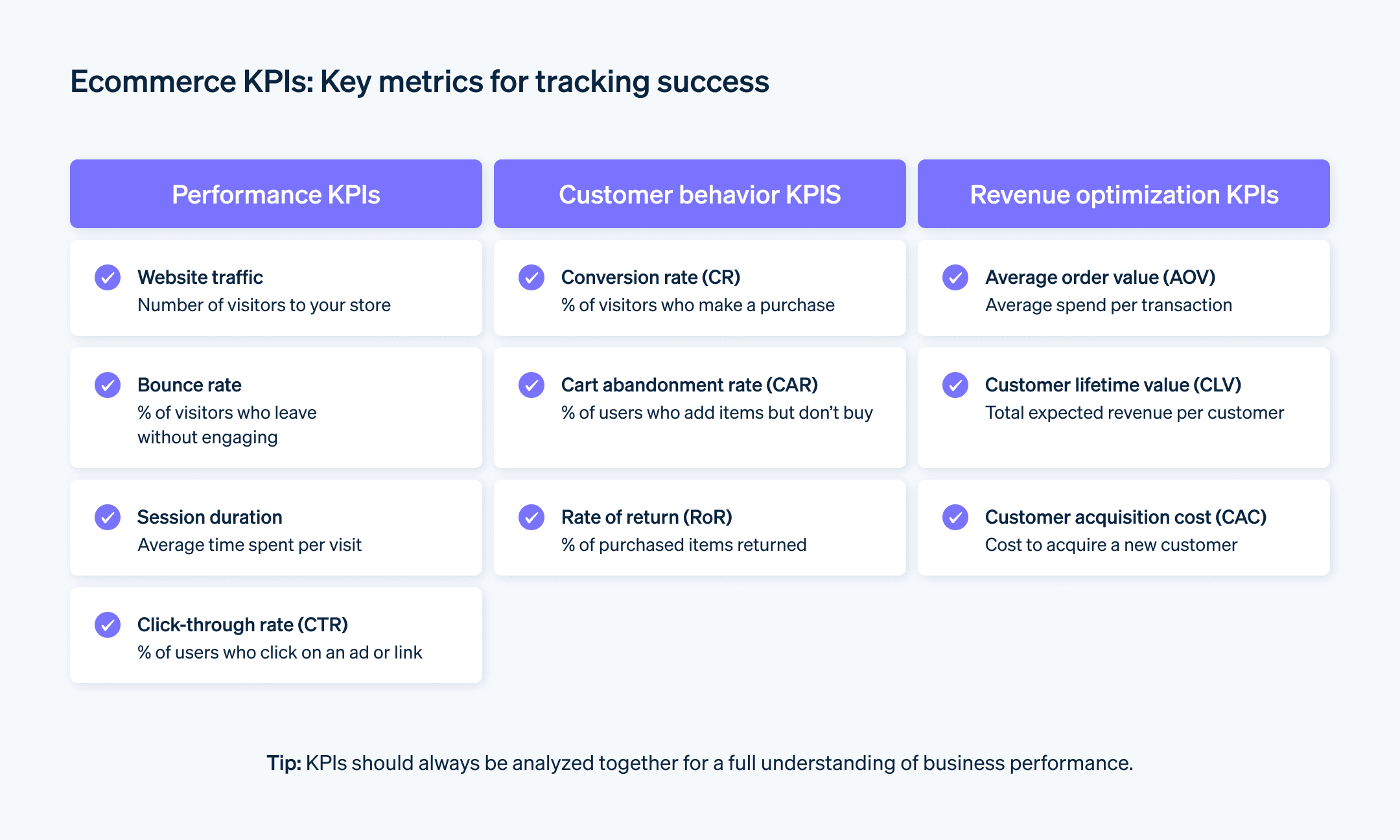了解什么是关键绩效指标 (KPI),哪些关键绩效指标对您的在线商店成功最为重要,以及为什么您应该定期监控它们。
本文内容
- 什么是电子商务?
- 什么是电子商务关键绩效指标,为什么它们很重要?
- 电子商务中最重要的关键绩效指标是什么?
- 为什么必须始终相互关联地衡量关键绩效指标?
什么是电子商务?
电子商务指的是通过互联网买卖商品和服务。电子商务为企业提供了无数好处,例如扩大客户群、提供更大的产品范围灵活性以及能够随时销售。
为了在电子商务中取得成功,了解当前趋势和发展并相应反应非常重要。这包括优化移动设备或将社交媒体渠道整合到销售过程中。
什么是电子商务关键绩效指标,为什么它们很重要?
对于电子商务企业来说,准确衡量和分析其在线商店的成功至关重要,以保持长期成功并扩展业务。为此,他们需要衡量正确的指标以提供其业务表现的完整图景。这些指标被称为“关键绩效指标”,简称“KPI”。关键绩效指标是揭示电子商务业务中某些过程或活动成功程度的衡量。它们包括转化率、平均订单价值和每月订单数量。
当企业定期监控和优化其关键绩效指标时,这不仅有助于使业务更成功,还突出了需要改进的领域。没有关键绩效指标,很难知道哪些业务领域或过程在运作,哪些没有。关键绩效指标代表了一种有价值的工具,用于准确衡量电子商务业务的成功并增加销售。对于企业来说,熟悉这一主题并仔细选择关键绩效指标非常重要。

电子商务中最重要的关键绩效指标是什么?
在线业务中一些最重要的关键绩效指标包括转化率,即访问者与实际购买者之间的比率,以及平均订单价值 (AOV),它揭示了商店中平均购买的价值。客户终身价值 (CLTV) 也是一个重要的关键绩效指标,因为它告诉您单个客户在其“生命周期”内在商店中花费了多少。
其他相关关键绩效指标包括放弃率或退货率。通过定期分析和优化这些指标,您可以提高商店的表现并最终增加销售。
熟悉以下关键绩效指标:
网站流量
电子商务业务的成功高度依赖于网站接收的访问者数量。网站流量(即每天访问者数量或页面访问次数)是了解您的网站接收多少流量的关键。跳出率和会话持续时间(见下文定义)也相关,因为它们提供了用户浏览网站所花费时间或是否直接转到另一页面的信息。
流量来源
流量来源是衡量营销活动成功的关键指标。它提供了访问者如何到达您网站的问题的答案。有许多类型的流量来源,如自然点击、付费点击或社交媒体。每个来源都有其优缺点,应适当分析。
衡量流量来源的另一个因素是识别趋势。通过识别数据流量中的模式,您可以快速行动并优化您的策略。
转化率 (CR)
转化率 (CR) 衡量达到目标与网站访问者数量的比率。这些目标可能是购买、新闻稿注册或联系查询。为了实现其目标,企业应确保其在线商店用户友好且易于找到产品。
跳出率 (BR)
跳出率 (BR) 告诉您有多少访问者在没有浏览在线商店或购买的情况下离开您的网站。高跳出率表明您的网站有些问题,因此您可能需要进行更改以吸引更多客户并实现更高的转化率。
点击率 (CTR)
点击率代表广告点击次数与广告展示次数(称为展示次数)之间的比率。展示次数显示用户查看网站或广告的次数。每次广告出现在用户屏幕上构成一次展示。
高点击率意味着目标群体对企业的信息反应良好并对其提供感兴趣。记住转化率也很重要,因为它显示有多少用户然后在您的网站上执行了所需操作。
客户获取成本 (CAC)
客户获取成本 (CAC) 表示获取新客户的成本。这意味着计算所有用于获取和保留新客户的营销和客户关怀支出。通过衡量客户获取成本,企业可以优化其营销策略并监控其措施的有效性。
客户终身价值 (CLV)
客户终身价值揭示了客户在与企业的关系期间预计在产品和服务上花费多少。高客户终身价值意味着客户长期对企业有利可图,因此值得投资于他们的忠诚度。
计算客户终身价值时需要考虑不同因素,如客户的平均订单量和频率以及他们对企业的忠诚度。
平均订单价值 (AOV)
平均订单价值 (AOV) 衡量客户与在线商家每订单的平均花费。此关键绩效指标帮助企业了解每订单花费多少以及每订单赚取多少利润。平均订单价值可以帮助识别客户购买行为中的趋势,并代表有关企业市场研究和竞争力的宝贵信息来源。
购物车放弃率 (CAR)
购物车放弃率 (CAR) 表示客户在没有完成购买的情况下终止支付过程的频率。高 CAR 可能归因于多种因素,如网站导航不良、支付方式有限或高运费。
退货率 (RoR)
退货率 (RoR) 表示客户购买后退货的产品数量。企业可以使用此信息开发更好、定制的策略以实现较低的退货率。
网站停留时间 (TOS)
网站停留时间或每页访问时间提供了关于访问者在网站(或其子页面)上花费多长时间以及他们访问哪些页面的信息。长时间停留可能意味着客户感兴趣并更有可能购买。然而,短时间停留可能表明网站不相关、难以导航或视觉上不吸引人。
会话持续时间
会话持续时间描述了在网站上定期进行主动交互的时间段。如果在 30 分钟内没有进一步操作,会话将被宣布结束。与网站停留时间不同,会话持续时间考虑了客户在网站上花费的整个时间。基于这些数据,可以对网站进行优化。
为什么关键绩效指标应始终与其他关键绩效指标相关联地衡量?
为了尽可能有效地衡量电子商务业务的成功,关键绩效指标绝不能单独考虑。相反,它们应始终与其他关键绩效指标相关联地衡量。这使得能够全面了解业务及其客户的体验。单独的关键绩效指标在孤立情况下可能不足以提供信息以做出关于业务战略的明智决策。
有关如何计算单个关键绩效指标的更多信息可以在我们的 SaaS 指标文章中找到。利用关键绩效指标提供的可能性将您的电子商务业务提升到新的水平。
本文中的内容仅供一般信息和教育目的,不应被解释为法律或税务建议。Stripe 不保证或担保文章中信息的准确性、完整性、充分性或时效性。您应该寻求在您的司法管辖区获得执业许可的合格律师或会计师的建议,以就您的特定情况提供建议。